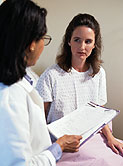
TUESDAY, Aug. 10 (HealthDay News) — Women’s cholesterol levels vary throughout their menstrual cycle as their levels of estrogen rise and fall, a new study reveals.
This means that to get a clear picture of a woman’s cholesterol levels, doctors may need to take readings over several months before deciding whether the patient needs to have her levels lowered, the researchers noted.
“Doctors who are looking at women [for] high cholesterol have to take into account the phase of the menstrual cycle they are at when they take the measurement,” said study co-author Enrique F. Schisterman, chief of the Epidemiology Branch at the Eunice Kennedy Shriver National Institute of Child Health and Human Development.
To make cholesterol readings more consistent and reliable, measurements should be taken at the same time each month for a couple of cycles, Schisterman added.
“Practically, it’s easier to recognize the beginning of a cycle,” he said. “So if you do it consistently at the beginning of the cycle then you will get consistent measures over time.”
The report is published in the current online edition of the Journal of Clinical Endocrinology and Metabolism.
For the study, Schisterman’s group compared levels of estrogen with cholesterol and triglyceride levels in 259 healthy women, aged 18 to 44. Most of the women (94 percent), had 14 or more measurements taken over two menstrual cycles. The women also charted the phases of their cycles using at-home fertility monitors that detect hormone levels indicating ovulation.
Most of the women were physically active and did not smoke. Only 5 percent had cholesterol levels higher than 200 mg/dL, which is borderline high-risk for heart disease. But, cholesterol levels among 19.7 percent of the women reached 200 mg/dL at least once.
In addition, some obese women over 40 had greater fluctuation in cholesterol levels than did the rest of the group, the researchers noted.
The researchers found that as estrogen levels rise, HDL, or “good” cholesterol also rises, peaking at ovulation.
At the same time, as estrogen levels increased, total and LDL, or “bad” cholesterol, as well as levels of triglycerides, fell, Schisterman’s team found. This decline began a couple of days after estrogen levels peaked at ovulation.
In addition, levels of total cholesterol, LDL cholesterol and triglycerides were lowest just before the start of menstruation, the researchers noted.
“This is more recognition that hormones play a very important role in women’s lives on all levels, including basic tests, like the test for cholesterol,” Schisterman said. “The menstrual cycle plays a very important role in women’s overall health.”
Dr. Jennifer Glueck, an assistant professor of clinical medicine in the division of endocrinology, diabetes and metabolism at the University of Miami Miller School of Medicine, said that “I really wasn’t aware that the levels of the lipids could fluctuate like that over the course of the menstrual cycle.”
However, the finding may not be particularly clinically relevant to this group of young women, Glueck said.
“These are young healthy women that you wouldn’t be considering to start cholesterol-lowering medications on,” she said. “It doesn’t seem like it pushed them into categories where you would initiate treatment.”
So while the finding is interesting, it probably won’t change clinical practice, she noted.
More information
For more information on cholesterol, visit the American Heart Association.

